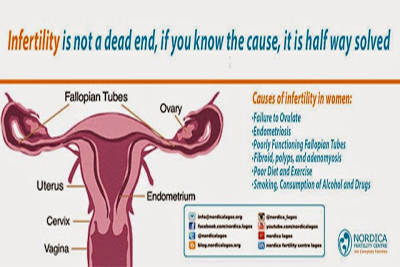What Causes Infertility In Some Women?
What Causes Infertility In Some Women?

Failure To Ovulate
Ovulatory disorders are one of the most common reasons why women are unable to conceive, and account for 30% of women’s infertility.
The causes of failed ovulation can be categorized as follows:
- Hormonal Problems: ovulation depends on a complex balance of hormones and their interactions to be successful, any disruption in this process can hinder ovulation. There are three main sources causing this problem:
- Failure to produce mature eggs,
- Malfunction of the hypothalamus,
- Malfunction of the pituitary gland.
- Scarred Ovaries: Physical damage to the ovaries may result in failed ovulation. For example, extensive, invasive, or multiple surgeries, for repeated ovarian cysts may cause the capsule of the ovary to become damaged or scarred, such that follicles cannot mature properly and ovulation does not occur.
- Premature Menopause: Some women cease menstruation and begin menopause before normal age. It is hypothesized that their natural supply of eggs has been depleted or that the majority of cases occur in extremely athletic women with a long history of low body weight and extensive exercise. There is also a genetic possibility for this condition.
- Follicle Problems: “unruptured follicle syndrome” occurs in women who produce a normal follicle, with an egg inside of it, every month yet the follicle fails to rupture. The egg, therefore, remains inside the ovary and proper ovulation does not occur.
Endometriosis
This condition is characterized by excessive growth of the lining of the uterus, called the endometrium. Growth occurs not only in the uterus but also elsewhere in the abdomen, such as in the fallopian tubes, ovaries and the pelvic peritoneum. A positive diagnosis can only be made by diagnostic laparoscopy, a test that allows the physician to view the uterus, fallopian tubes, ovaries and pelvic cavity directly. The symptoms often associated with endometriosis include heavy, painful and long menstrual periods, urinary urgency, rectal bleeding and premenstrual spotting. Sometimes, however, there are no symptoms at all, owing to the fact that there is no correlation between the extent of the disease and the severity of the symptoms.
30-40% of patients with endometriosis are infertile. This is two to three times the rate of infertility in the general population. For women with endometriosis, the monthly fecundity (chance of getting pregnant) diminishes by 12 to 36%.
Poorly Functioning Fallopian Tubes: Tubal disease affects approximately 25% of infertile couples and varies widely, ranging from mild adhesions to complete tubal blockage.
The main causes of tubal damage include:
- Infection
- Abdominal Diseases
- Previous Surgeries
- Ectopic Pregnancy
Additional Factors:
Conditions of the uterus such as fibroid, polyps, and adenomyosis may lead to obstruction of the uterus and Fallopian tubes.
Congenital abnormalities, such as septate uterus, may lead to recurrent miscarriages or the inability to conceive.
Behavioral / Environmental Factors:
- Poor Diet and Exercise
- Smoking
- Consumption of Alcohol and Drugs
- Exposure to Lead
- Exposure to Radiation, ranging from simple x-rays to chemotherapy, has been shown to contribute to a wide array of ovarian problems.





